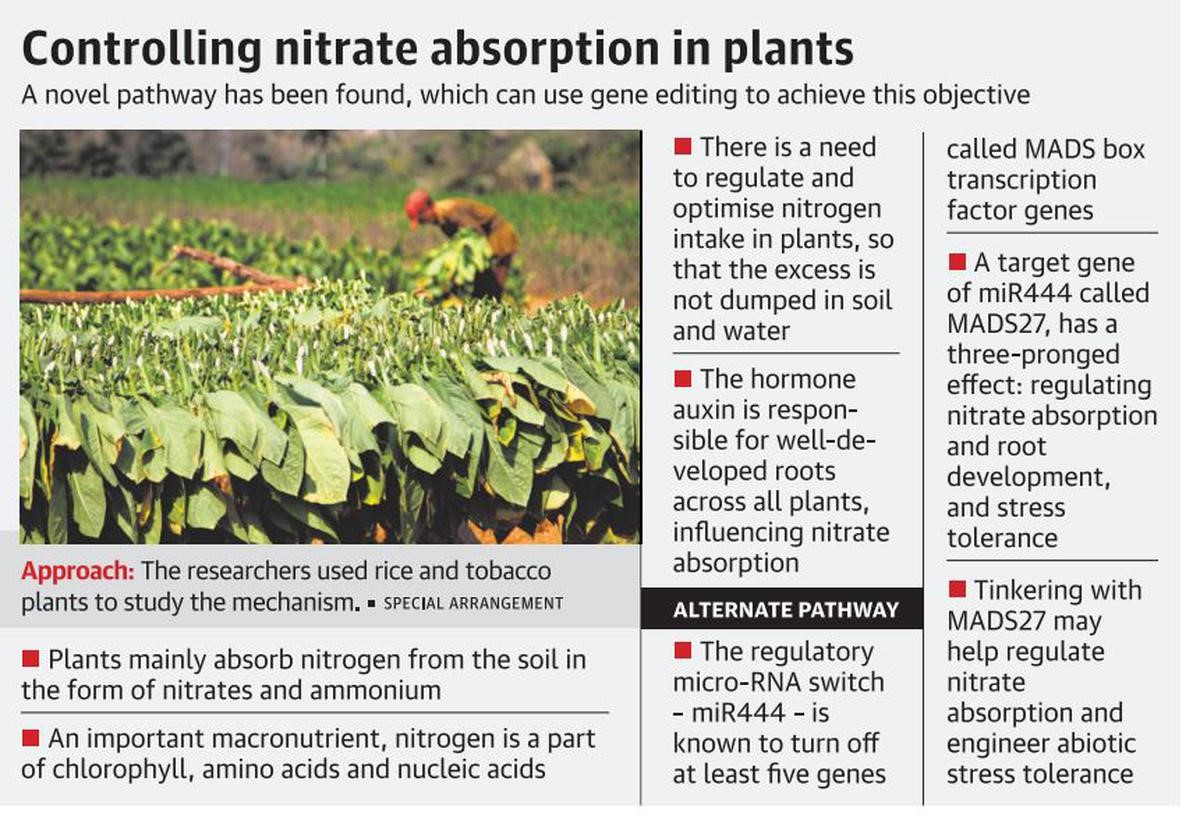Published on: July 5, 2022

NITRATE ABSORPTION IN PLANTS
NITRATE ABSORPTION IN PLANTS

Why in news?
Researchers led by those from the National Centre of Biological Sciences, Tata Institute of Fundamental Research, Bengaluru (NCBS-TIFR), have found a new pathway that regulates nitrate absorption in plants.
Highlights:
- The gene MADS27, which regulates nitrate absorption, root development and stress tolerance, is activated by the micro-RNA, miR444, therefore offers a way to control these properties of the plant.
- The researchers studied this mechanism in both rice (monocot) and tobacco (dicot) plants. The research is published in Journal of Experimental Botany.
Nitrogen and its importance:
- Nitrogen is one of the most important macronutrients needed for development of a plant.
- It is a part of chlorophyll, amino acids and nucleic acids, among others.
- It is mostly sourced from the soil where it is mainly absorbed in the form of nitrates and ammonium by the roots.
- Nitrates also play a role in controlling genome-wide gene expression that in turn regulates root system architecture, flowering time, leaf development, etc.
- Thus, while a lot of action takes place in the roots to absorb and convert nitrogen into useful nitrates, the absorbed nitrates in turn regulate plant development apart from being useful as a macronutrient.
- So, the presence of nitrates is important for the plant development and also for grain production
Nitrate overuse
- The overuse of nitrates in fertilizers, for instance, can lead to the dumping of nitrates in the soil which leads to accumulation of nitrates in water and soil. This accumulation adds to soil and water pollution and increased contribution to greenhouse gases.
What can be done?
- Since the whole process of nitrate absorption takes place in the roots, a well-developed root system is needed for this to take place optimally.
- At one level, it is known that the hormone auxin is responsible for well-developed roots across all plants. A number of genes are known to help with auxin production, improved nitrate transport and assimilation in plants.
- Regulatory switches: In addition to this route, several gene regulatory switches that regulate nitrate absorption and root development, such as the micro-RNA, miR444, are known in monocot plants, such as rice.
The micro-RNA ‘miR444’
- “The micro-RNA ‘miR444’ is specific to monocots. When this is not made, its target, MADS27, is produced in higher abundance, and it improves biosynthesis and transport of the hormone auxin, which is key for root development and its branching
- This regulatory miR444 switch is known to turn off at least five genes called MADS box transcription factor genes.
- The speciality of the MADS box transcription factors is that they function like switch boxes of their own. They bind to their favourite specific DNA sequences and they switch the neighbouring genes “on.”
Three-pronged effect
- The researchers have studied a target gene of miR444 called MADS27, a transcription factor which hasn’t been studied well before.
- They have found that this transcription factor has a three-pronged effect on the plant.
- First, it regulates nitrate absorption by switching “on” proteins involved in this process. Second, it leads to better development of the roots by regulating auxin hormone production and transport.
- Finally, and somewhat surprisingly to the researchers, it helps in the abiotic stress tolerance by keeping the main stress player proteins “on.”
Dicot plants
- To test this in dicot plants as well, the researchers carried out the study on tobacco plants as well.
- They realised MADS27 works to improve three factors — nitrate absorption, root development and stress tolerance — with the help of RNA analysis and after finding to which part of the genome this transcription factor binds.
-
According to the researchers, the gene MADS27 appears to be an excellent candidate to modify, in order to develop nitrogen use efficiency, which is something that helps the plant absorb more nitrates, and to engineer abiotic stress tolerance.

